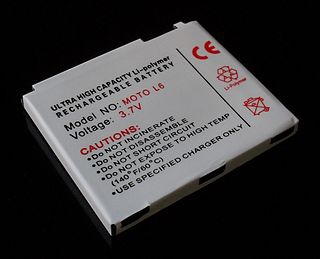
Li Bai, also known as Li Bo, courtesy name Taibai, art name Qinglian Jushi, was a Chinese poet acclaimed from his own day to the present as a genius and a romantic figure who took traditional poetic forms to new heights. He and his friend Du Fu (712–770) were the two most prominent figures in the flourishing of Chinese poetry in the Tang dynasty, which is often called the "Golden Age of Chinese Poetry". The expression "Three Wonders" denotes Li Bai's poetry, Pei Min's swordplay, and Zhang Xu's calligraphy.

A lithium polymer battery, or more correctly lithium-ion polymer battery, is a rechargeable battery of lithium-ion technology using a polymer electrolyte instead of a liquid electrolyte. High conductivity semisolid (gel) polymers form this electrolyte. These batteries provide higher specific energy than other lithium battery types and are used in applications where weight is a critical feature, such as mobile devices, radio-controlled aircraft and some electric vehicles.

Gupta was the founder of the Gupta dynasty of northern India. He is identified with king Che-li-ki-to, who, according to the 7th century Chinese Buddhist monk Yijing, built a temple near Mi-li-kia-si-kia-po-no (Mṛgaśikhāvana) for Chinese pilgrims.

Li Po Chun United World College of Hong Kong, established in 1992, is an International Baccalaureate boarding school in Wu Kai Sha (烏溪沙), Hong Kong, within walking distance of Wu Kai Sha station. It is the eighth member of the today 18-member United World Colleges movement and is the first United World College in Asia.

Puli Township is an urban township in Nantou County, Taiwan. The township is located within the Puli Basin. It is the geographic center of Taiwan.

Romeo Must Die is a 2000 American action film directed by Andrzej Bartkowiak in his directorial debut, featuring fight choreography by Corey Yuen, and starring Jet Li and Aaliyah in her film debut which also marked the sole film released during her lifetime. It follows a Chinese former police officer travelling to the United States in order to avenge his brother's death. He also falls in love with a rival mobster's beautiful daughter as they struggle together against both the Chinese and the American mobs. The film's plot is loosely related to William Shakespeare's Romeo and Juliet but transplanted to contemporary Oakland, California, with the feuding families becoming African-American and Chinese-American gangs.

Lithiophilite is a mineral containing the element lithium. It is lithium manganese(II) phosphate with chemical formula LiMnPO4. It occurs in pegmatites often associated with triphylite, the iron end member in a solid solution series. The mineral with intermediate composition is known as sicklerite and has the chemical formula Li(Mn,Fe)PO4). The name lithiophilite is derived from the Greek philos (φιλός) "friend," as lithiophilite is usually found with lithium.

Triphylite is a lithium iron(II) phosphate mineral with the chemical formula LiFePO4. It is a member of the triphylite group and forms a complete solid solution series with the lithium manganese(II) phosphate, lithiophilite. Triphylite crystallizes in the orthorhombic crystal system. It rarely forms prismatic crystals and is more frequently found in hypidiomorphic rock. It is bluish- to greenish-gray in color, but upon alteration becomes brown to black.

Kickboxer is a 1989 American martial arts film directed by David Worth and starring Jean-Claude van Damme. Former world kickboxing champion Dennis Alexio is also featured. It spawned several sequels.
Huang Yu-chun, known by her final stage name Ivy Ling Po, is a retired Hong Kong actress and Chinese opera singer. She is best known for a number of mega-hit Huangmei opera films in the 1960s, especially The Love Eterne (1963) which made her an Asian superstar overnight. She played an important role in the entertainment industry for preserving the Huangmei opera art form.
The lithium iron phosphate battery or LFP battery is a type of lithium-ion battery using lithium iron phosphate as the cathode material, and a graphitic carbon electrode with a metallic backing as the anode. The energy density of an LFP battery is lower than that of other common lithium ion battery types such as Nickel Manganese Cobalt (NMC) and Nickel Cobalt Aluminum (NCA), and also has a lower operating voltage. Because of its lower cost, low toxicity, long cycle life and other factors, LFP batteries are finding a number of roles in vehicle use, utility scale stationary applications, and backup power. LFP batteries are cobalt-free.

Li Haiqiang is a former Chinese-born Hong Kong professional footballer. He played for various professional clubs and also the Hong Kong national football team. Li played the role of a midfielder and is nicknamed "The Golden Left Foot" because of his brilliant free kick skills.

Lithium iron phosphate (LFP) is an inorganic compound with the formula LiFePO
4. It is a gray, red-grey, brown or black solid that is insoluble in water. The material has attracted attention as a component of lithium iron phosphate batteries, a type of Li-ion battery. This battery chemistry is targeted for use in power tools, electric vehicles, solar energy installations and more recently large grid-scale energy storage.

Master Ping Xiao Po is the title character and protagonist of the Kung Fu Panda franchise. He is an anthropomorphic giant panda who is improbably chosen as the champion of the Valley of Peace in the first film. Po is the prophesied Dragon Warrior, as well as the Warrior of Black and White.

Hureaulite is a manganese phosphate with the formula Mn2+5(PO3OH)2(PO4)2·4H2O. It was discovered in 1825 and named in 1826 for the type locality, Les Hureaux, Saint-Sylvestre, Haute-Vienne, Limousin, France. It is sometimes written as huréaulite, but the IMA does not recommend this for English language text.

Dell Li Hon Ho is a former professional football player and current player for Hong Kong First Division club Tai Po. He played as a goalkeeper.
Kung Fu Panda is an American media franchise by DreamWorks Animation, consisting of three films: Kung Fu Panda (2008), Kung Fu Panda 2 (2011), and Kung Fu Panda 3 (2016). The first two were distributed by Paramount Pictures, while the third film was distributed by 20th Century Fox. Three shorts, Secrets of the Furious Five (2008), Kung Fu Panda Holiday Special (2010), and Kung Fu Panda: Secrets of the Masters (2011), were also released. A television series for Nickelodeon television network, Kung Fu Panda: Legends of Awesomeness, premiered in 2011. A second series, Kung Fu Panda: The Paws of Destiny, was released on Amazon Prime in November 2018.

Kung Fu Panda 3 is a 2016 computer-animated action comedy film produced by DreamWorks Animation and distributed by 20th Century Fox worldwide and by Oriental DreamWorks in China. It is the third installment in the Kung Fu Panda franchise and the sequel to Kung Fu Panda 2 (2011). In the film, Po is reunited with his birth father and discovers the existence of a secret Panda Village, but must soon learn to master chi and prepare the pandas to fight against Kai, a spirit warrior intent on destroying Oogway's legacy.

NASICON is an acronym for sodium (Na) Super Ionic CONductor, which usually refers to a family of solids with the chemical formula Na1+xZr2SixP3−xO12, 0 < x < 3. In a broader sense, it is also used for similar compounds where Na, Zr and/or Si are replaced by isovalent elements. NASICON compounds have high ionic conductivities, on the order of 10−3 S/cm, which rival those of liquid electrolytes. They are caused by hopping of Na ions among interstitial sites of the NASICON crystal lattice.

Lithium aluminium germanium phosphate, typically known with the acronyms LAGP or LAGPO, is an inorganic ceramic solid material whose general formula is Li
1+xAl
xGe
2-x(PO
4)
3. LAGP belongs to the NASICON family of solid conductors and has been applied as a solid electrolyte in all-solid-state lithium-ion batteries. Typical values of ionic conductivity in LAGP at room temperature are in the range of 10–5 - 10–4 S/cm, even if the actual value of conductivity is strongly affected by stoichiometry, microstructure, and synthesis conditions. Compared to lithium aluminium titanium phosphate (LATP), which is another phosphate-based lithium solid conductor, the absence of titanium in LAGP improves its stability towards lithium metal. In addition, phosphate-based solid electrolytes have superior stability against moisture and oxygen compared to sulfide-based electrolytes like Li
10GeP
2S
12 (LGPS) and can be handled safely in air, thus simplifying the manufacture process. Since the best performances are encountered when the stoichiometric value of x is 0.5, the acronym LAGP usually indicates the particular composition of Li
1.5Al
0.5Ge
1.5(PO
4)
3, which is also the typically used material in battery applications.


















